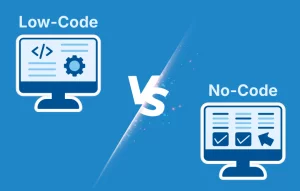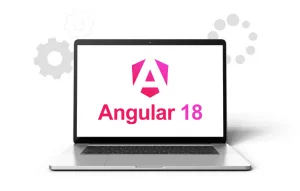JavaScript has long been hailed as the king of the front-end in the constantly evolving realm of web development. What about its server-side potential? JavaScript for the backend has been steadily gaining ground, offering a powerful and versatile solution for building robust, scalable, and efficient web applications. As the demand for dynamic and responsive websites continues to soar, the importance of choosing the right backend technology becomes more evident than ever.
In this blog, we’ll delve into the realm of backend JavaScript, exploring the top frameworks and libraries that have been making waves in the industry. Whether you’re a seasoned developer looking to expand your skill set or someone new to the world of web development, this blog will provide you with insights into the technologies that are currently in high demand and poised to shape the future of JavaScript for web development.
From harnessing the versatility of Node.js to exploring the myriad of frameworks and tools at your disposal, we’ll uncover the reasons behind JavaScript’s growing popularity in the backend ecosystem. To discover the tools that can propel your projects to new heights, let’s dive in and explore the top backend JavaScript technologies that are taking the development world by storm.
Exploring the essential JS tech stack
When it comes to backend development with JavaScript, having the right technology stack is crucial. Each component in your tech stack plays a unique role in ensuring your application’s performance, scalability, and maintainability. Let’s take a closer look at some of the key players in the backend JavaScript frameworks.
Node.js: The foundation of many backend JavaScript web applications, Node.js is renowned for its speed and efficiency. It allows you to build server-side applications using JavaScript and benefits from a vast ecosystem of packages, making it a versatile choice for a wide range of projects.
Express.js: A minimal and flexible Node.js web application framework, Express.js simplifies building robust APIs and web applications. It’s widely appreciated for its simplicity and the speed at which you can develop applications.
Meteor: Meteor is a full-stack JavaScript framework designed for building real-time web applications. Its reactivity and ease of use make it an attractive option for developers looking to create modern, responsive apps quickly.
Sails.js: Sails.js is another Node.js framework known for its ease of use and real-time capabilities. It is particularly well-suited for building data-driven APIs and applications, with a focus on making the development process straightforward.
Koa: A more modern alternative to Express.js, Koa emphasizes a smaller and more expressive core, giving developers more control over their application’s flow. It’s especially popular for its support of async/await, making it a choice for developers who want to write cleaner, more readable code.
Restify: Restify is a Node.js framework optimized for building REST APIs. It’s lightweight and focused on performance, making it an excellent choice for developing API services that require speed and scalability.
Keystone.js: Keystone.js is a content management system (CMS) and web app framework built on top of Express.js. It’s designed for developers who want to create dynamic web applications with a strong emphasis on content management and user authentication.
Backbone.js: Although more commonly associated with front-end development, Backbone.js can also be used on the server-side. It’s a lightweight framework that can help structure your application and provide the necessary tools for building web services.
Nuxt.js: Nuxt.js is a framework for building server-rendered applications with Vue.js. While it’s primarily known for front-end development, it also provides server-side rendering capabilities, making it a powerful choice for universal applications.
In the world of backend JavaScript, these technologies are the building blocks that enable developers to craft powerful and dynamic web applications. Choosing the right combination of these tools can make a substantial difference to your project’s success.
Features of the essential JS tech stack
Node.js:
High performance: Node.js is famous for its non-blocking, event-driven architecture, which translates into impressive performance and the ability to handle a large number of concurrent connections.
Vast ecosystem: The Node Package Manager (NPM) provides access to a massive repository of open-source packages, allowing developers to extend their applications with ease.
Express.js:
Simplicity: Express.js offers a minimalist framework that simplifies routing, middleware management and server configurations. This simplicity accelerates development without compromising functionality.
Middleware: Express.js is renowned for its middleware system, which enables developers to add features and functionalities to their applications seamlessly.
Meteor:
Real-time functionality: Meteor’s expertise lies in real-time application development, with features like automatic data synchronization, making it perfect for applications that require live updates and interactivity.
Full-stack framework: Meteor provides a full-stack solution, covering both the client and server sides of the application, which streamlines development and reduces integration challenges.
Sails.js:
Auto-generated APIs: Sails.js stands out with its ability to auto-generate RESTful APIs, saving developers time and effort in setting up routes and controllers.
Real-time capabilities: Much like Meteor, Sails.js also excels in real-time functionality, making it suitable for building live chat applications, collaborative tools, and more.
Koa:
Async/await support: Koa’s primary feature is its full support for async/await, simplifying asynchronous code and enhancing readability.
Modular and lightweight: It is known for its modular design, allowing developers to pick and choose the components they need, resulting in a lightweight and tailored framework.
Restify:
Speed and scalability: Restify specializes in creating high-performance REST APIs, designed to deliver speed and scalability for demanding applications.
HTTP extensibility: It offers powerful HTTP features that allow for customization and fine-tuning of the API endpoints.
Keystone.js:
Content management: Keystone.js is expert in content management, making it a superb choice for projects that involve extensive content creation, management, and organization.
User authentication: It provides built-in user authentication features, simplifying the process of securing your applications.
Backbone.js:
MVC architecture: Backbone.js enforces a Model-View-Controller (MVC) structure, which helps in organizing code and keeping it maintainable.
Front-end and server integration: While its primary use is on the front-end, it can also play a role in structuring server-side applications, bridging the gap between client and server development.
Nuxt.js:
Server-side rendering: Nuxt.js is an expert in server-side rendering, boosting application performance, SEO-friendliness, and user experience by rendering pages on the server before they reach the client.
Universal applications: It enables the creation of universal applications, seamlessly transitioning between client-side and server-side rendering for the best of both worlds.
JavaScript usage statistics from various sources:
- JavaScript serves as the client-side programming language for approximately 98.7% of websites worldwide, totaling around 49,501,698 websites.
- An impressive 81.8% of JavaScript developers actively use React.js, with 47.2% expressing an interest in mastering this JavaScript framework in the near future.
- JavaScript takes the crown as the most popular and sought-after programming language, securing the 3rd position in the prestigious PYPL Index.
- Worldwide, nearly 3,491,140 websites harness the capabilities of the JavaScript framework known as Vue.js.
- Next.js emerges as the dominant backend JavaScript framework, with 68.6% of JavaScript developers opting for it, surpassing Nuxt and Express.
- JavaScript asserts its dominance over Java with an impressive 95.76% market share.
- A staggering 97% of mobile developers turn to JavaScript for cross-platform mobile app development, highlighting its significance in the mobile development landscape.
How to choose the best backend JavaScript framework
1. Define your project requirements: Start by understanding the specific needs of your project. Is it a real-time application, a content management system, an API service, or something entirely different? Define your project’s goals, scalability requirements and any special features you need.
2. Consider the learning curve: Evaluate the learning curve associated with each framework. If you or your teams are already familiar with a particular framework, it might be the quickest route to development. However, don’t be afraid to learn a new one if it better suits your project’s needs.
3. Performance and scalability: Consider the performance demands of your application. If you anticipate handling several concurrent connections or require real-time capabilities, Node.js and frameworks like Sails.js or Meteor may be excellent choices. If you need a lightweight and efficient framework, consider Koa or Restify.
4. Community and ecosystem: The strength of a framework’s community and ecosystem is crucial. A vibrant community ensures ongoing support, a wealth of resources, and a growing pool of developers who can contribute to your project. Node.js, Express.js, and Meteor have particularly active communities.
5. Choose the right technology:
- Flexibility and modularity: Some frameworks, like Express.js, Koa, and Backbone.js, offer high levels of flexibility and modularity. This allows you to tailor your application to your exact needs and integrate only the components you require.
- Real-time capabilities: If real-time functionality is a central requirement, look for frameworks like Meteor or Sails.js. These frameworks excel at building applications that require instant data synchronization and live updates.
- SEO considerations: If SEO is a concern for your project, consider frameworks with server-side rendering capabilities like Nuxt.js. Server-side rendering can significantly improve your application’s search engine visibility.
- Security: Evaluate the security features and practices of your chosen framework. Security is paramount, especially for applications that handle sensitive data. Consider frameworks with robust security features and follow best practices for securing your application.
6. Cost and licensing: Keep in mind the cost and licensing implications. Many JavaScript backend frameworks are open-source, but it’s essential to understand the licensing terms. Ensure the licensing aligns with your project’s goals and budget.
7. Compatibility: Consider how well the framework integrates with other technologies you plan to use, such as databases, front-end libraries, or third-party services. Compatibility and seamless integration can streamline development.
8. Performance benchmarks: If performance is a critical factor, look for performance benchmarks and real-world use cases that demonstrate the framework’s ability to handle your expected load and traffic.
9. Testing and documentation: Good testing and comprehensive documentation are indicators of a mature framework. Frameworks with a strong focus on testing and thorough documentation can simplify the development process.
By carefully considering these factors, you can make an informed decision when choosing the best backend JavaScript framework for your project. Each framework has its unique strengths and use cases, so selecting the one that aligns with your project’s requirements is the key to successful development and long-term success.
Embrace the future: Choosing the right backend JavaScript framework
In the dynamic realm of web development, choosing the right backend JavaScript framework is akin to selecting the perfect tool for the job. Having explored the capabilities of these frameworks, it becomes clear that the versatility, performance, and real-time capabilities offered by these frameworks have catapulted JavaScript into the spotlight for backend as a service.
By thoughtfully considering your project’s requirements, performance demands, community support and real-time needs, you can make a well-informed choice. Whether you opt for the simplicity of Express.js, the real-time prowess of Meteor, or the server-side rendering capabilities of Nuxt.js, you’re embracing the future of web development. The world of backend JavaScript is not just a trend; it’s a powerful and enduring force that’s shaping the digital landscape.
So, as you venture into your next backend development project, remember that the right framework can be your greatest ally, making your journey smoother, your applications faster, and your ideas more tangible. The future of backend JavaScript is here, and it’s a future worth looking forward to.










